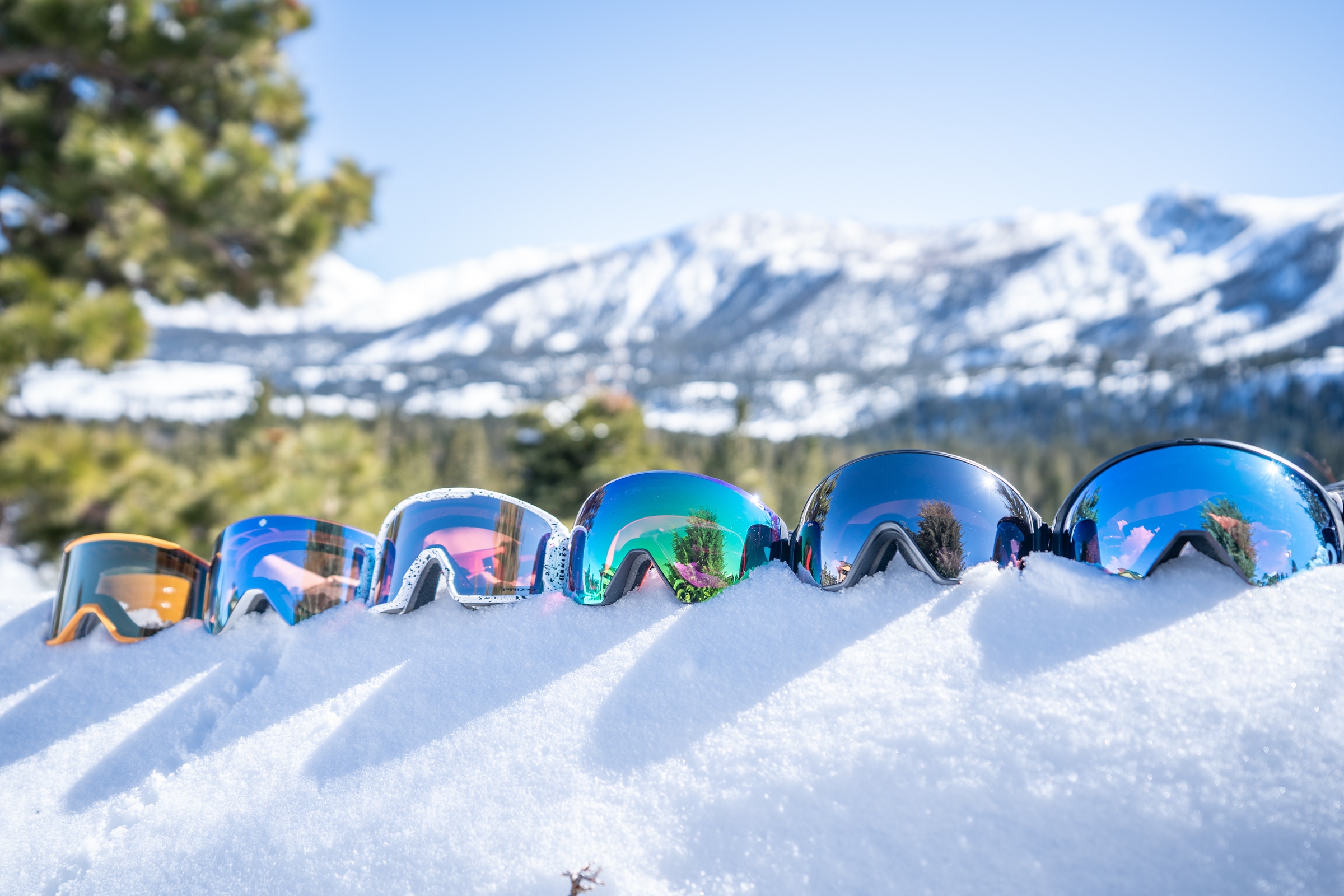Snow goggles are mission-critical for an enjoyable day on the slopes. The best ski and snowboard goggles protect your eyes from sun, snow and wind—not to mention wayward ski poles, Mach 10 snowballs and other hazards on the hill. Not only that, but goggles also help you scan the mountain in more detail as you ski or ride, so you can quickly adapt to variations in snow texture and terrain that might otherwise send you sprawling. No matter your skill level or destination, one thing is for sure: High-quality optics will improve your shred experience this winter.
To give you 20/20 vision as you choose your next pair, we had a dozen skiers and snowboarders test 21 top-of-the-line goggles available at REI. Those goggles ranged from affordable picks perfect for skiers on a budget to highly rated, higher-end customer favorites. After hundreds of days of skiing and snowboarding both inbounds and out, our testers narrowed the field down to five of the best goggles available for 2025. Whether you’re looking for the best value goggles, best goggles for medium or smaller faces or best over-the-glasses (OTG) goggles, we’ve got you covered.
Best All-Around Ski Goggles & Editors’ Choice Award Winner
Smith 4D MAG ChromaPop Snow Goggles with Lens Protector
Score 90
Interchangeable lenses Yes
Lens system Smith MAG
Additional lenses included 1
Lens shape Spherical
Frame size Medium
Our top pick for best all-around goggles, the Smith 4D MAG, is instantly recognizable by the downward curvature on the bottom of its aptly named "BirdsEye Vision" spherical lenses. Testers raved about the fact that the 4D MAGs' close-to-the-face medium frame fit offers a field of view comparable with larger goggles, minus the drawbacks of having to size up. "It's a fantastic pick for anyone with an average-size mug who doesn't like huge goggles," noted a tester who regularly rides in the California backcountry. (Smith also makes the 4D MAG with small and large frames as well as in low bridge fit.)
Smith claims the cutting-edge lens shape boosts field of view by 25% compared to its popular spherical I/O MAG. And our testers backed that up, confirming that the curved lens shape makes it easier to pick up objects and action in their peripheral field of view.
Our California-based tester sampled the 4D MAG side by side with other top picks and reported back. "I realized I was making subconscious head movements to increase my field of view with other goggles. Those movements were much less frequent in the 4D MAG. It was easier, for instance, to locate a walkie talkie fastened to my shoulder strap or navigate waist-high willow branches at speed." He did note, however, that there was distracting distortion if he looked straight down at the more aggressively curved portion of the lens.
A Colorado-based tester—our hardest to please—appreciated the goggles' peripherals but felt the field of vision "didn't live up to the hype." He also commented that the lens shape caused a hotspot on his nose bridge, a problem he didn't experience with more traditionally shaped lenses. (Pro tip: Try goggles on with your helmet!)
Critiques aside, our hard-to-please tester loved Smith's MAG interchangeable lens system, which uses eight magnetic contact points and two locking points. The locking mechanisms give the 4D MAG a strong connection between frame and lens, but the lens system isn't as fast to swap out on the chairlift. Still, our test crew loved the light-filtering ChromaPop lenses, Smith's proprietary lens tech that boosts color, clarity and definition.
Versions: 4D MAG S ChromaPop, 4D MAG S ChromaPop - Low-Bridge Fit, 4D MAG ChromaPop - Low-Bridge Fit 4D Mag XL ChromapopL
Bottom Line: A medium-size goggle with an innovative lens, the Smith 4D MAG ChromaPop let riders take in a wide peripheral field of view to nail their line every time.
Testing Stats:
- Days Out: 65+
- Testing locations: Alaska, California, Colorado and Utah
- Best testing story: "In Colorado, the weather changes all the time. I was out on one super stormy morning, and I was stoked to have the contrast and pop that the Storm Yellow Flash lens gives. Then, when the clouds cleared and it got brighter, I was able to switch over to a mid-light lens quickly and easily, and still have good clear vision and a wide field of view," reported our Rocky Mountain-based tester.
Best All-Around Ski Goggles with a Larger Fit
Atomic Revent Q HD Snow Goggles
Score 92
Interchangeable lenses Yes
Lens system Magnetic Q
Additional lenses included 1
Lens shape Toric
Frame size Large
While Atomic is better known for skis than goggles, we think the Revent Q HD Goggles might make you reconsider. The caliber and overall performance of these optics impressed our testers, who gave them top honors after trying them in freezing rain, sunshine and cloudy days.
It was love at unboxing for us, as the Revent comes in a nifty lightweight, EVA-molded foam travel case. “It protects lenses and goggles better than the typical sleeve,” appreciated one staffer who tested it while on a family ski trip to Canada’s Whistler Blackcomb ski resort. Every colorway comes with two lenses—one for low light, one for sunny conditions—and each lens features contrast-boosting HD tech as well as standard hydrophobic, anti-fog and anti-scratch treatments. “Incredible color and clarity,” he raved. “I put the darker green HD lens on for the first time and said, ‘Whoa’ out loud. The yellow/blue lens also exceeded expectations in flatter light.”
These lenses are toric, so they’re curved horizontally and vertically though less brow to cheek than ear to ear. Fun fact: This shape more closely mirrors the curvature of the human eyeball than perfectly spherical competitors. The result? “Zero distortion,” said our Oregon-based tester who co-signed the shape after several days of testing in intermittent freezing rain and overcast skies in the Cascade Mountains. Raved our Tahoe area snowboarder: “Between the large frame size and the toric shape, the peripherals are top-notch.”
To swap lenses, the Revent features both locking mechanisms and magnets, providing speed and security. “Pop the secure release, and the lenses come right out—what more can you ask for?” waxed our Oregon-based tester. Another tester had a minor gripe: When squeezing the goggles to move them from face to helmet, a magnet or two can pop free accidentally, creating a gap between the lens and frame. (This wasn’t a dealbreaker, as the issue can be avoided by grabbing the goggles at the temples instead of the nose bridge.)
Different face shapes, sizes and helmets are compatible with different goggles, so if the Revent works for your face and helmet shape, go for it. The Revent is best for skiers with broader faces or those who want a roomy fit. Our editor, who usually opts for low-bridge fit goggles, was impressed by the plush triple-layer face foam and the exact fit. Another skier tested the Revent with a different brand helmet and didn’t get the goggle-to-helmet seal he wanted. However, all testers who tried the goggles with the Atomic Revent helmet judged the pairing superb. “The front vents of the Revent helmet line up seamlessly with the goggle brow vents, circulating airflow and minimizing fogging,” said our Tahoe snowboarder, who has tested dozens of goggles.
Bottom Line: The Atomic Revent Q HD provides skiers and snowboarders with excellent optical clarity and contrast, solid lens interchangeability and undeniable style.
Testing Stats:
- Days out: 30
- Testing locations: British Columbia, California, Nevada, Washington
- Best testing story: “After back-to-back typical Northwest wet ski days, I struggled to brush off the precip that constantly pooled on my lenses and wondered why I bothered to ski in such conditions," reported our Seattle-based editor. "But the next morning, the clouds parted and Mount Rainier came into view; I popped on my second lens for bright conditions and whooped and hollered down the mountain.”
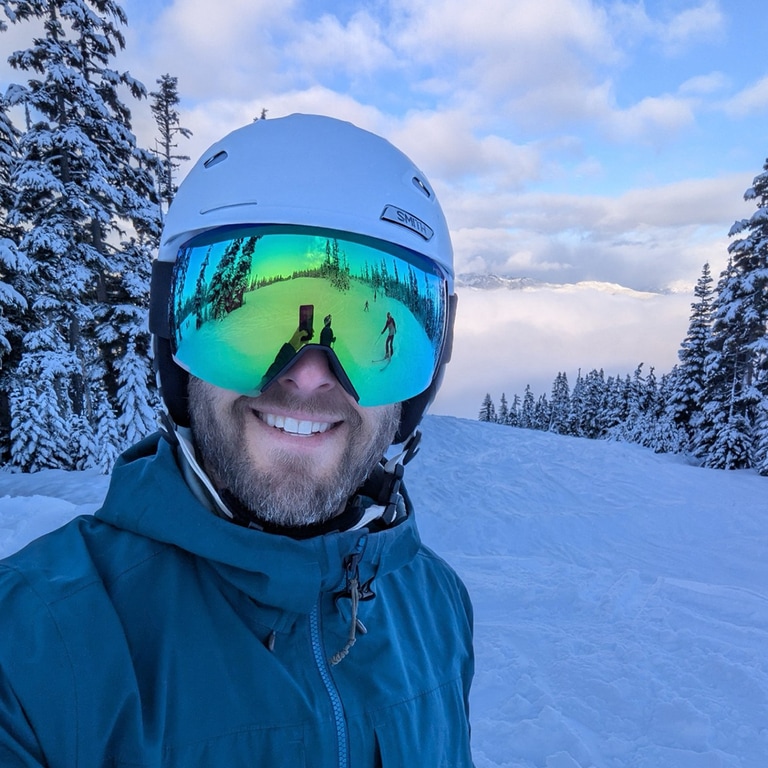
Best Cylindrical Ski Goggles
Smith Squad MAG ChromaPop Snow Goggles with Lens Protector
Interchangeable lenses Yes
Lens system Smith MAG
Additional lens included 1
Frame size Medium/Large
There are two main reasons we recommend cylindrical lens goggles: style and price. But those aren't the only alluring aspects of the Smith Squad MAG—optical quality, an easy lens interchangeability system, widespread helmet compatibility and more make this goggle a smart addition to any kit.
First, a bit about cylindrical goggles. Compared with spherical or toric lenses, which are curved across both the vertical and horizontal axes, cylindrical lenses are curved ear-to-ear but are flat brow-to-nose. Because of that, they're generally cheaper to manufacture. (We break down these lens types further below the reviews if you're interested in learning more). Our testers gave the Squad MAG a perfect score in the style department. They thought the cylindrical style had a more classic flair compared with spherical and toric lenses, which can look bug-eyed and futuristic. The large lenses and minimalistic, semi-frameless design—combined with a variety of strap options—make this Smith goggle "as clean as they come," according to one style-savvy snowboarder.
One knock on cylindrical lenses is that their flatness makes them more prone to distortion and optical imperfection. But our Tahoe-based lead tester, who has put multiple goggles to the test on slopes across U.S. and international destinations, felt the Squad MAG ranked with other heavy hitters in optics. "I mainly swapped between toric Anon goggles, spherical Smith I/O and the cylindrical Squad MAG run by run and day by day while testing. While those more curved lenses offer more optical perfection toward the peripherals, any distortion is minimal with the Squad MAG—you have to be looking for it," he said, nodding to the Smith tapered lens technology, which thins the cylindrical lenses toward the frame to minimize distortion. He continued: "The quality of the lens itself is fantastic." On that note, optically obsessed shredders will be stoked to learn the Squad MAG is available with the same top-of-the-line, color- and clarity-enhancing ChromaPop tech as the priciest, award-winning option from Smith. (Pro Tip: If you're looking for a more affordable option and love the Squad's style, forgo the MAG system and get a tried-and-true Squad for half the price.)
Style and price aren't the Squad MAG's only selling points either. Vents at the top integrate with brow vents found on Smith helmets to seamlessly boost airflow and minimize fogging while riding. That said, we did fog up these goggles while bootpacking on warm days. Still, the brow of the Squad is flat, allowing solid compatibility with several helmets like the Smith Method and Giro Grid Spherical Helmet, and rarely had issues with dreaded goggle gap. What's more, the three-layer foam is comfortable on the face, and the easily adjustable silicone-backed strap stays put on the helmet no matter how hard you're charging.
It's the interchangeable lens system, though, that makes the Squad a bargain in our book. Like the Magna-Tech® popularized by Anon, the Smith MAG interchangeable lens system relies on magnets to snap the lenses into place. But unlike the Anon system, Smith also uses two locking levers to provide a more secure fit. It isn't as quick, but our test team loved the additional sense of security while swapping lenses on chairlifts or on top of backcountry lines.
Versions Squad MAG ChromaPop Snow Goggles With gogglesoc - Low-Bridge Fit
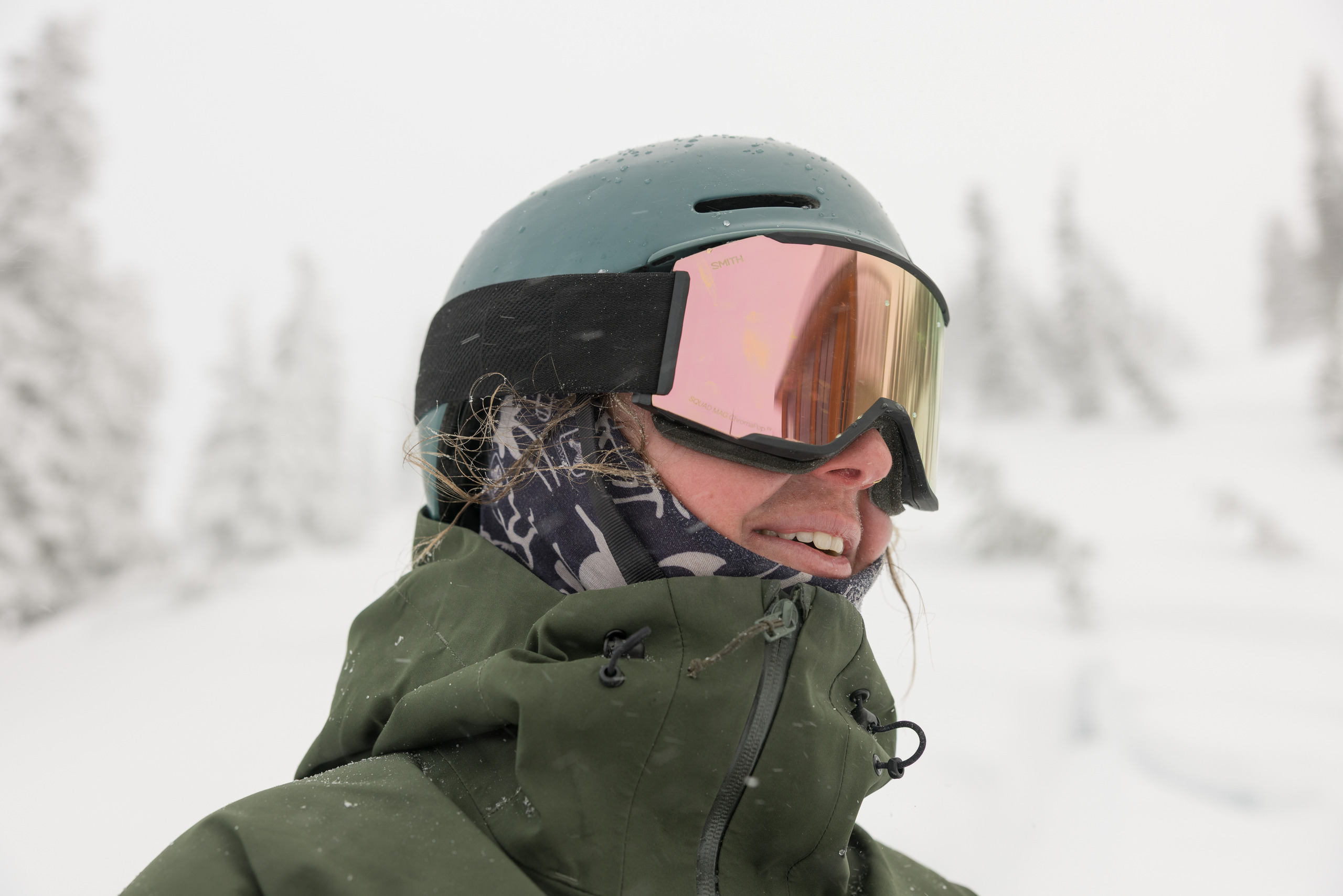
Bottom Line: For premium optics and unmatched style without spending $300+ for a pair of goggles, the Smith Squad MAG is a perfect choice.
Testing Stats:
- Days Out: 30+
- Testing Locations: California, Utah, France, Japan, Switzerland
- Best Testing Story: "I was testing during a relatively warm yet stellar powder day in France. It was misty and hard to see, and we were bootpacking mini pillows and cliffs and traversing aggressively while exploring the sidecountry," says one tester from California. "My goggles were fogging up like mad—I don't blame the Squads for that. I could've been wearing sunglasses, and they would've been fogged up like a bathroom mirror after a hot shower. But what I loved about the Squad is the magnetic interchangeable lens system. I was able to quickly swap out fogged lenses on top of lines or while riding the gondola back up the hill, ensuring I always had a clear lens when it counted most."
Best Value Ski Goggles
goodr Apres All Day Snow Goggles
Score 84
Interchangeable lenses Yes
Lens system Magnetic
Additional lenses included 1
Lens shape Cylindrical
Frame size Medium
Ski goggles aren’t just expensive—they’re also notoriously easy to scratch, damage or lose. If you’re constantly scratching expensive lenses, losing goggles on powder day yard sales or just looking to save up for exorbitantly priced burgers at the base lodge, these Goodr snow goggles offer incredible value at just $75 a pop. (For reference, a replacement lens for a high-end goggle can easily cost more than a pair of Goodr goggles.) And the Goodr goggles’ performance and tech are surprisingly solid given the price point.
Before we dive into the details, one important note: You’ll find several Goodr ski goggles available at REI. While these goggles have different offbeat names like Here for the Hot Toddies or Radioactive Zebroids, they’re all the same in terms of sizing and specs. The difference is in the colorway and lens tint, but you can even swap lenses between goggles.
A goggle with a magnetic lens interchangeability system and two lenses at this price point is next-level value, and our testers were impressed. “I tested the darker tints on bright bluebird powder days in Tahoe, sending it off cliffs that required all of my focus, and Goodr’s cylindrical lenses performed well,” recounted our expert Tahoe-area snowboarder. He gave the goggles top marks for style as well, digging the low-profile, black-on-black Après All Day colorway.
So what does $75 get you? A medium-sized frameless goggle with two anti-fog and anti-glare cylindrical lenses, one for bright conditions and another for low-light. The lens interchangeability system relies on magnets—a feature that stoked our test team from the jump. Our testers also found the goggle to be plush with a comfy foam liner that fits well against the face, and liked the adjustable, grippy, silicone-lined strap that keeps the goggles locked onto your helmet or beanie. The whole kit comes in a protective zippered case with a microfiber bag that doubles as a goggle wipe.
Still, our tester who rides frequently found some aspects lacking. These budget goggles just can’t beat the contrast, clarity and crispness of higher-end lenses like the Smith 4D Mag, and he still prefers toric lenses, which come with a higher price tag. “The cylindrical Goodr goggles have a bit of optical distortion in the peripherals. They also seem to scratch a little easier,” he says. “But my biggest gripe is that the magnetic lens system is flimsier and less secure relative to others I tested.”
Our more intermediate tester, however, had concerns with goggle performance and loved the design, aesthetic and overall vibe. “They looked great with my kit—big-time style!”
Gear nerds who tally their ski days may want to skip these in favor of higher-performance goggles. But beginners, casual intermediates, budget-conscious skiers, families and others will find that the Goodrs are a stellar value option. Buy here.
Bottom Line: For budget-conscious boarders and skiers or casual resort goers, the Goodr snow goggles are as awesome as they are affordable.
Testing Stats:
- Days Out: : 15
- Testing locations:: California, Nevada
- Best testing story: While a tester waited for the infamous KT-22 lift at Palisades Tahoe to open on a snowy powder day, the storm clouds lifted, revealing sunny skies. Our tester ran back to his car, swapped lenses and hustled back to the base for fresh tracks.
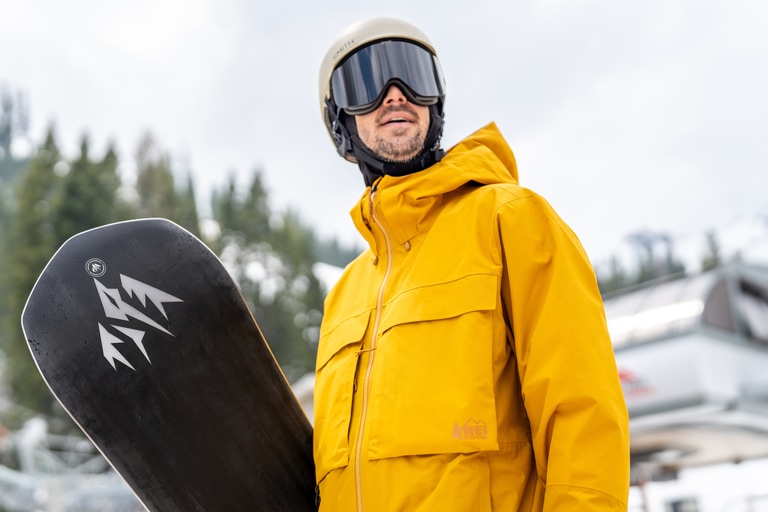
Best Over-the-Glasses Ski Goggles
Smith Reason OTG Snow Goggles
Score 80
Interchangeable Lenses Replaceable, not interchangeable
Additional lenses included None
Lens shape Cylindrical
Frame size Large
Smith's offerings have always been a smash hit with the glasses gang, and the Reason OTG continues the tradition. Purposefully designed with prescription eyewear in mind, the Reason OTG sports a large, wide cylindrical lens and an accommodating, flexible, polyurethane frame.
While one tester noticed some pressure on the arms of her glasses, she liked that the Reason OTG fit easily over her chunkier frames. "If your glasses have a slimmer frame, you should be fine," she said.
Aside from eyewear compatibility, the most attractive aspect of the Reason OTG was the reasonable price tag. Testers found the Carbonic-X lenses decent—they're not on par with Smith's top-of-the-line ChromaPop featured on the 4D MAG—but contrast and clarity were on point. "Durability was solid, too," commented another tester after misplacing the Reason OTG's goggle bag on a road trip, only to get their goggles home unscathed.
Honorable Mention
Oakley Target Line L Snow Goggles
Score 81
Interchangeable Lenses Replaceable, not interchangeable
Additional Lenses Included None
Lens Shape Cylindrical
Oakley goggles often retail for close to $200, so snagging a pair for around $100 or so is a bargain that understandably had our testers asking, "What's the catch?" Not much, according to our crew, who wore the Target Line in the Wasatch and Sierra ranges and found that the compromise was, in fact, minimal.
At this price point, you get a low-profile, flat-browed, flexible frame padded with triple-layer foam that's "comfortable and compatible with most helmets," reported one of our testers.
Oakley keeps costs low on the Target Line by offering a relatively basic lens. You won't find Prizm™ lens tech—Oakley's premium optic option found in other tester-beloved favorites like the popular Flight Deck and cylindrical Line Miner. Instead, the Target Line features a less expensive but still highly capable Plutonite lens. The dark gray anti-fog dual Plutonite lens that we tested provides defense against UV rays, didn't fog up during testing, and even exceeded expectations in sunny conditions.
The classic cylindrical lens, lean frame and silicone-lined strap stamped with the classic "O" logo deliver the style we expect from Oakley. Speaking of aesthetics, testers appreciated the Target Line's monotonic colorways. "The black-on-black style had a fly-under-the-radar vibe to it that I really dug, but there are brighter options if you want to add flash to your kit," wrote one freestyle-oriented fashionista.
A tester who owns and loves a pair of Oakley Line Miners with a dark Prizm™ lens was impressed by the quality of the Target Line. "I expected a dramatic step down in quality ... I'm a bit optics-obsessive and found myself comparing these goggles side by side [with my Line Miners] in the resort parking lot one day, and while I noticed the difference, you have to be actively looking for it," they said.
You won't find a second lens when you unbox the Target Line, and while you can replace lenses, it's not a chairlift-friendly process. With this in mind, testers recommended the Target Line for folks who are building a kit from scratch or already own one pair of goggles and are looking for a second.
Bottom Line: If you’re on a budget, the low-cost, high-style Oakley Target Line is a bullseye.
Testing Stats:
- Days Out: 12
- Testing locations: California
- Best Testing Story: "After testing the Target Line for a bit, I thought I'd go rock my [Oakley] Line Miners for a day to compare the two. I grabbed 'em out of the trunk, got laced up, and took a couple laps before it dawned on me: I was still rocking the Target Line!"
Buying Advice for Ski and Snowboard Goggles
Between the tech and the number of options available, shopping for goggles can be overwhelming. Here, we break down factors to help you choose, including lens interchangeability systems, lens tints, sizing, fit and helmet compatibility. (Also, learn more in our article How to Choose Ski & Snowboard Goggles).
Goggle Lens Shape
Goggles today feature a variety of lens shapes. Here are the shapes you should know.
Cylindrical lenses: This lens curves left-to-right across your eyes and face, but the lens surface is vertically flat (between the nose and forehead). Cylindrical lenses often cost less to manufacture and don’t supply the best optics—the flatness can cause glare and slightly reduce peripheral vision. However, many snowboarders and skiers dig the style and price.
Spherical lenses: This lens, too, curves across your eyes and face, but it also curves vertically. Spherical lenses are generally more expensive than cylindrical ones, but they’re closer to the natural shape of the human eye, minimizing the potential for distortion. They can also offer better peripherals.
Toric lenses: Like spherical lenses, toric lenses are curved both horizontally and vertically. However, the curvature isn’t uniform. Toric lenses like the Atomic Revent Q HD generally aren’t as curved vertically as they are horizontally, and the subtle curvature from forehead to nose helps toric lenses more closely imitate the curvature of the eyeball.
Lens Tints and Visible Light Transmission
Lenses come in a rainbow of tints—and, contrary to popular belief, it’s not so you can match your goggles to your jacket. Different tints allow different amounts of light to transmit through the lens and into your eye; the amount of light that passes through the lens is measured as a percentage known as Visible Light Transmission (VLT). A 0% VLT lets no light pass through—think eye mask—while a 100% VLT is completely clear.
Oftentimes, when you add a goggle to your shopping cart, you’ll have the opportunity to select from multiple lens tints. Or, if you’re shopping for an interchangeable lens goggle, you’ll see different pairs of lenses, usually a low-light lens and a dark-tint lens. Use the info below to help you make the right selection for the conditions you ride in most frequently.
Darker tints for sunny conditions: Darker options—like black, brown and copper—usually have low VLTs. Once you start creeping over a VLT of 20%, you’re approaching a mid-range VLT that’s better for sunny and mixed conditions as opposed to pure bluebird days.
Mid-range tints for partly cloudy conditions: Mid-range tints vary tremendously in color, from greens and blues to pinks and reds, and range in VLT from the 20s to the 50s. If you’re looking for one lens to do it all—which we don’t recommend—hovering near a VLT of 25% isn’t a horrible idea. That’s dark enough to handle sunny days, but it’s light enough to work in partly cloudy conditions. VLTs of 40%, 50% and up are much better suited for partly cloudy conditions and storm days.
Lighter tints for cloudy and stormy conditions: Light tints, like amber, gold and rose, typically have higher VLTs—meaning they let more light in—and are better suited for cloudy, stormy and low-light conditions. Our favorite low-light lenses have VLTs over 60%, but they aren’t versatile—if the sun pops, you’ll be squinting.
Clear lenses: Clear lenses—lenses with no tint at all—can have a VLT as high as 100% since they aren’t blocking any light at all. You wouldn’t want to use them on a sunny or partly cloudy day, but they’re excellent for night skiing.
A caveat on lens color: Pay more attention to VLT than the color of the lens. For instance, a pale, translucent gold lens might be perfect for storm skiing, while a reflective gold lens might be better for bluebird days. Making decisions based on VLT will steer you in the right direction.
Lens Interchangeability Systems—and Why We Love Them
Most of our favorite goggles boast interchangeable lens systems, which allow you to swap out lenses while relying on a single goggle frame. The best interchangeable lens systems are quick and easy to navigate—even while wearing gloves—and offer a secure, gap-free connection between frame and lens. Here are a few reasons why we recommend going the interchangeable route:
You'll be better prepared for changing conditions: Goggles with interchangeable lens systems typically come with two options: a low-light lens for cloudy conditions and a dark lens for brighter conditions. Unless you only ride on bright days, it pays to have both options available. Picking the right lens for the current light will improve your time on the slopes immensely.
You want to downsize your kit: Some skiers and riders choose to own two pairs of goggles—one for brighter days and another for cloudy ones. This is fine. However, a single frame with multiple lenses may be much easier to transport than two or three separate pairs of goggles.
One interchangeable system may be cheaper than owning several pairs: Goggles with interchangeable lenses aren’t cheap. But it’s often comparable—even cheaper—to get one pair of interchangeable-lens goggles with two or three lenses than to buy two or three individual pairs of goggles.
Interchangeable lens systems vs. replacement lenses: You can buy a replacement lens for most goggles on the market, but “replaceable” and “interchangeable” aren’t synonymous. Goggles that have replaceable lenses like the Oakley Target Line tend to be priced lower than interchangeable ones. Replacing a lens on a standard pair of goggles isn’t necessarily easy or quick, and it’s quite possible that you’ll leave your paw prints all over the lenses as you tug at the frame and try to lock the new lens into place. This explain why standard goggles only come with a single lens, while interchangeable-lens goggles are pricier and come with an extra lens.
Photochromic Lenses
Now that you have a basic understanding of VLT, let’s talk photochromic lenses. Also referred to as “transition lenses,” photochromic lenses automatically adjust to ambient light: The tint darkens in sunshine and lightens in shady, cloudy or stormy conditions. Here are the pros and cons of photochromic lenses:
Pros:
Your lenses adapt to changing conditions, adding versatility that goes a long way in the mountains, where weather can shift quickly and dramatically.
You might be able to get away with a single pair of goggles with a single lens, saving you space in your pack and, depending on the goggle cost, money.
Cons:
Photochromic tech doesn’t work immediately, which means you can be skiing a shaded tree run, then pop into the sunshine and struggle to see because your goggles didn’t adjust in time.
The axiom “jack of all trades, master of none” is an apt description of photochromic lenses. They can handle many conditions well, but they don’t provide the clarity and contrast of a premium, fixed-VLT lens at the extremes.
Sizing and Fit
Sizing and fitting goggles is key to enjoying your time on the slopes. Here are a few tips to keep in mind.
Helmet compatibility: To get the best fit, make sure to try on goggles with your helmet. You want to eliminate any “gaper gap” (the gap between your helmet and goggles) both for style and functionality in gnarly weather. Also, make sure there aren’t any uncomfortable pressure points on your nose, forehead or the corners of your eyes. If you’re starting from scratch and shopping for a helmet, too, look for one that’s the same brand as your goggles; there's a better chance of finding a flush, perfectly compatible fit. (If you’re in the market for a brain bucket, check out our helmet guide for our top-rated helmet picks.
Learn more: The Best Snow Helmets: Tested
Flush fit: You're looking want a comfortable snug fit—no gaps at the nose or corners of the eyes, as wind and snow can work their way into the slimmest of openings. The best way to size and fit goggles is to swing try on several options.
Sizing Breakdown
As you peruse goggle descriptions, you’ll see fit and size described a few ways, several of which we’ve broken down below.
Large or oversize goggles: Large or oversize goggles are intentionally big. Bigger lenses like the Atomic Revent Q HD tend to offer a better field of view—and many skiers and snowboarders love the style. Generally, these work best for folks with larger heads.
Medium goggles: Medium-fit goggles, like the Smith 4D MAG, are the sweet spot that work for most skiers and boarders. They’re popular with riders with average-size heads.
Small goggles: Small goggles are popular with riders with smaller heads, as well as teens and kids who have outgrown youth sizes.
Women’s goggles: While many goggles are unisex, women’s goggles are engineered specifically for women. These sizes will be comparable to small or medium unisex goggles. Some include stylistic differences, too.
Low-bridge fit: If you have a narrow or smaller nose bridge and often find a pesky gap between your face and goggles, try low-bridge fit goggles—a solution to this common fit issue. The Smith 4D MAG, for example, is also available in a low-bridge fit.
Kids’ goggles: When shopping for your little ripper, opt for goggles specifically sized for youth, as they’ll be swimming in standard sizes.
Methodology
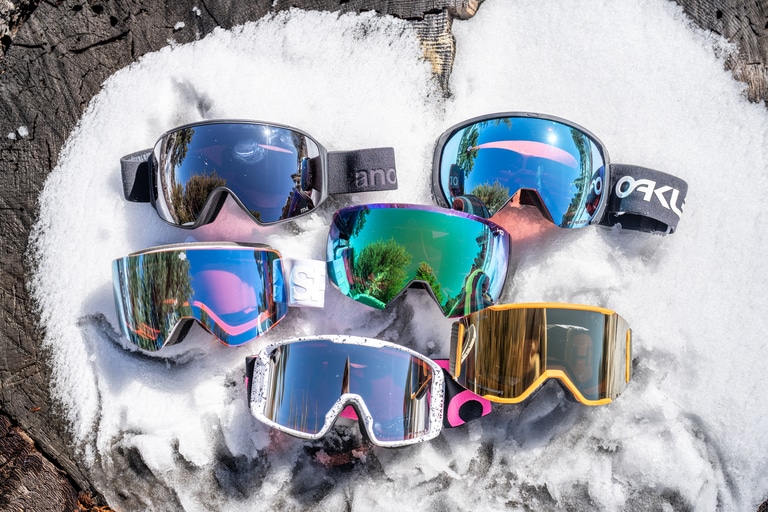
To find the best ski and snowboard goggles, our product team and ski and snowboard experts has been sifting through mountains of goggles from top brands at REI and constantly checking out new ones as they come on line and replacing those that are no longer in stock. Of these contenders, we've selected more than two dozen to test over several seasons. Some goggles were new releases, while others were longtime favorites that our gear experts have been assessing for years in locales like Japan and British Columbia. The goggles ran the gamut in price, size, style and tech.
Then, we recruited 21 member-testers—including skiers and snowboarders ranging in age from 7 to 53—to put the goggles to the test during the past ski seasons, mostly in California and Washington, but also in Alaska, Colorado, Nevada, Utah, Wyoming, Japan and Canada's British Columbia.
Testers scored goggles on lens quality, helmet compatibility, comfort and fit, ease of interchangeability, glasses compatibility (if relevant), value, durability, peripherals, style, ventilation, and overall performance, awarding a score out of 100 for each category. The scores you see are cumulative averages. Testers then answered questions on goggle pros and cons and reviewed lenses and frames. Finally, our test director tallied scores, analyzed feedback, assessed top performers and wrote these reviews.
